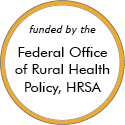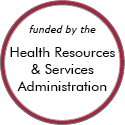Idaho Models and Innovations
These stories feature model programs and successful rural projects that can serve as a source of ideas. Some of the projects or programs may no longer be active. Read about the criteria and evidence-base for programs included.
Effective Examples
The Health-able Communities Program

Updated/reviewed August 2024
- Need: Expand healthcare access for the more remote residents of 3 frontier counties in north central Idaho.
- Intervention: With early federal grant-funding, a consortium of healthcare providers and community agencies used a hybrid Community Health Worker model to augment traditional healthcare delivery services in order to offer a comprehensive set of health-related interventions to frontier area residents.
- Results: With additional private grant funding, success continued to build into the current model of an established and separate CHW division within the health system's population health department.
Other Project Examples
Targeted Rural Underserved Track (TRUST) Program

Updated/reviewed April 2025
- Need: There is a shortage of rural physicians in the Northwestern United States.
- Intervention: University of Washington medical students are receiving training through the TRUST program in rural communities across a five-state radius.
- Results: Long-lasting connections have been formed among regional communities, medical students, and rural health professionals, with the goal of producing more rural physicians.
The Hospital Cooperative Charge Comparative
Updated/reviewed October 2024
- Need: To help hospitals in rural Idaho and Wyoming see how their prices compare to others in the region.
- Intervention: The Hospital Cooperative (THC) completes an annual charge comparative, which lists the highest, lowest, average, and median price for a specific charge.
- Results: THC has offered these reports since 2010.
The Hospital Cooperative Mobile MRI
Updated/reviewed October 2024
- Need: Critical Access Hospitals in Idaho were not able to afford a fixed MRI system.
- Intervention: The hospitals partnered to purchase a mobile MRI unit to travel among facilities.
- Results: The MRI unit went into service in 2012, providing hundreds of scans per month and traveling among six member hospitals in rural Idaho.
COSSA Advanced EMT Class
Added July 2024
- Need: To increase the number of Advanced Emergency Medical Technicians (Advanced EMTs) in rural Idaho and neighboring states.
- Intervention: An Advanced EMT class offered to students at five rural high schools, the first of its kind in the country.
- Results: Two students graduated from the class in its first year, with at least two more expected to enroll in the 2024-25 school year.
The Hunger Coalition's Bloom Truck and Bloom Markets
Added July 2023
- Need: To improve access to healthy, affordable food for low-income families and children in Blaine County, Idaho in a stigma-free way.
- Intervention: A truck that delivers free, healthy meals to kids in local neighborhoods and a farm stand selling fresh produce at heavily discounted rates.
- Results: The Bloom Truck delivers meals to between 250 and 400 children each summer, with 1,599 meals served in June of 2023.
Last Reviewed: 12/29/2023

